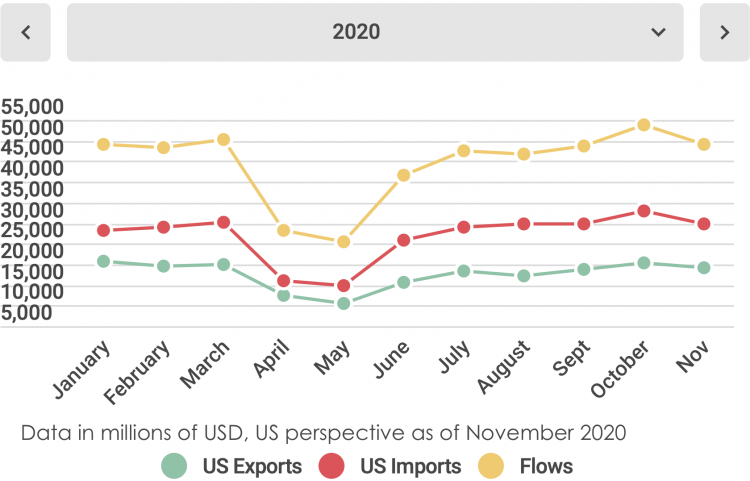 TREND: In November 2020, bilateral trade flows decreased 8.36% compared to the previous month, however this trend is similar to the last 8 years as trade between October and November has contracted by an average of 5.97% since 2010. U.S. imports from Mexico in November of this year were the highest they have ever been in any November. The fact that trade between October and November did not oscillate outside expected parameters is a positive sign of continuing trade recovery in both countries. The latest data shows that the gap in total year-to-date flows between 2019 and 2020 continued to tighten between October and November. However, China grew its participation as a top US trade partner, and is positioned to close out 2020 as the US’ largest trade partner.
TREND: In November 2020, bilateral trade flows decreased 8.36% compared to the previous month, however this trend is similar to the last 8 years as trade between October and November has contracted by an average of 5.97% since 2010. U.S. imports from Mexico in November of this year were the highest they have ever been in any November. The fact that trade between October and November did not oscillate outside expected parameters is a positive sign of continuing trade recovery in both countries. The latest data shows that the gap in total year-to-date flows between 2019 and 2020 continued to tighten between October and November. However, China grew its participation as a top US trade partner, and is positioned to close out 2020 as the US’ largest trade partner.
•US-Mexico bilateral trade shows consistent trends throughout the years. US imports from Mexico in November were higher than last year by 2.32%, but US exports to Mexico decreased by 7.82%. US exports to Mexico in November have been decreasing consistently for the last 3 years.
•Total US-Mexico bilateral trade has continued to recover consistently between June and November. Bilateral trade between the US and Mexico has contracted 13.92% year-on-year, which is a 1.17 percentage point improvement compared to last months’ year to date contraction of 15.09%. The total trade flow difference between 2019 and 2020 has been consistently decreasing since June.
US-Mexico Total Trade (2020)
Click here for AmCham’s Trade Dashboard English – Spanish

•As of November 2020, Mexico is still the second top trade partner of the US, with China rising from third to first between September and October. Total US-Mexico trade equals US $488.87 billion or 14.3% of total US trade, which is now lower to China (US $503.6 billion) but still larger than Canada (US $478.3 billion). In 2020, the top 5 US trade partners are China, Mexico, Canada, Japan, and Germany. China’s percentage of total US trade grew from 14.4% to 14.7% between October and November while the rest of the countries’ percentages stayed the same.
•As of November 2020, Mexico remains the second top export destination for US products (14.9% share of total) behind Canada (17.9%) and ahead of China (8.5%). Mexico continued to expand its share of percent of total US exports by 0.1 percentage points this month compared to last month (from 14.8% to 14.9%). US exports to China increased 0.3 percentage points during the period, outperforming Mexico.
•Meanwhile, China remains the top source of US imports (18.6% of total), followed by Mexico (13.9%) and Canada (11.6%). Between August and November 2020, the US increased its percent of total imports from China by 0.9% (17.7% to 18.6%), 0.3 percentage points just in November (18.3% – 18.6%). The US only increased its imports from Mexico by 0.2% (13.7% to 13.9%) during the same period. This pushed China ahead of Mexico as its largest trade partner since October.
•In November 2020, most US imports from Mexico decreased compared to October; the categories that grew the most were the (i) animal & vegetable fats, oils & waxes (25.66%), (ii) live animal & animal products (11.83%) , and (iii) precious stones, metals, pearls & coins (8.02%). As we mentioned previously, prolonged confinement has been behind the rise of agricultural and animal product exports, which are projected to keep growing in the coming months as Covid-19 cases rise. However it is surprising that manufacturing sector exports in Mexico decreased during November.
•During the same period, US exports to Mexico decreased in most sectors, except for two: (i) vegetable products (9.73%) and, (ii) animal & vegetable fats, oils & waxes (6.89%). Works of Art & Antiques decreased 25.32% compared to October, which was the biggest decrease last month.
TAKEAWAY: US-Mexico bilateral trade continued to recover in November even though it decreased compared to October 2020. However US imports from China continue to grow at a faster rate than Mexico’s, and is strengthening its position as the US’ top trading partner. President Biden’s future relationship with China, particularly his policies around the US-China trade war, decoupling, and the US’ adhesion to the CPTPP will impact the future of US-Mexico trade. Good news is that the year-to-date trade flows gap between 2019 and 2020 have continued to narrow even further this month. As bilateral trade continues to recover, the alarming rise of cases on both sides of the border, and the fact that some key manufacturing states in Mexico have reached critical hospital capacity might impact trade in the first quarter of 2021. Rapid rollout of the Covid-19 vaccine and controlling cases in the first quarter of the year will be critical to maintaining trade recovery and competing with China’s rise in exports.
* Spotlight by AmCham/Mexico´s Trade & Investment Center. The American Chamber of Commerce of Mexico seeks to facilitate commercial integration between Mexico and the US, build a favorable business environment, and contribute with proposals to consolidate Mexico’s competitiveness and development as a top destination for American investment. By connecting companies and sharing trends and market intelligence, its Trade & Investment Center boosts cross-border business. Twitter: @amchammexico


